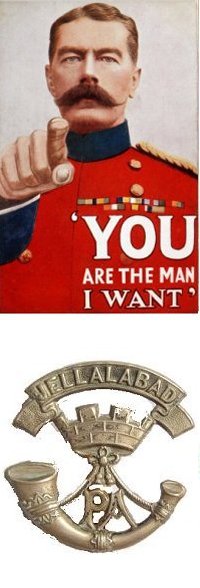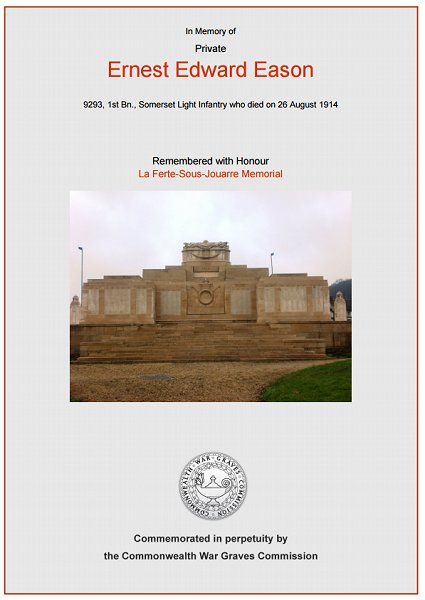yeovil at War
Ernest Edward Eason
Killed in action at the Battle for Le Cateau
Ernest Edward Eason was born in Yeovil Marsh in 1894, the son of agricultural labourer Henry William Eason (1857-1920) and Martha Jane née Short. In the 1901 census Henry and Martha were living at Nobles Nap with their nine children; Philip (b1884), John (b1885), Ada (b1889), Ellen (b1891), Lily (b1893), Rose (b1893), 6-year old Ernest, Charles (b1896) and Beatrice May (b1898). The family were still at Nobles Nap at the time of the 1911 census (2/3 April) but with only four of the children still at home; Lily, Ernest, Charles and Beatrice (and two had died) during the previous ten years.
Sixteen-year old Ernest gave his occupation as a house painter in the census but within weeks had left his job and enlisted at Yeovil as a Private in the 1st Battalion, Somerset Light Infantry, giving his occupation as a painter's labourer. His Service Number 9293 indicating that he enlisted at the end of April or beginning of May 1911. While the 2nd Battalion was sent to China in 1911, the 1st Battalion remained on Home Service, and in 1914 was stationed in Colchester as part of 11th Brigade, 4th Division.
 Britain
declared war on
Germany on 4
August 1914 and
on 9 August the
British
Expeditionary
Force (BEF)
began embarking
for France.
Unlike
Continental
European armies,
the BEF in 1914
was exceedingly
small. At the
beginning of the
war the German
and French
armies numbered
well over a
million men
each, divided
into eight and
five field
armies
respectively;
the BEF had
around 80,000
soldiers in two
corps of
entirely
professional
soldiers made up
of long-service
volunteer
soldiers and
reservists. The
BEF was probably
the best trained
and most
experienced of
the European
armies of 1914.
British training
emphasised
rapid-fire
marksmanship and
the average
British soldier
was able to hit
a man-sized
target fifteen
times a minute,
at a range of
300 yards (270m)
with his
Lee–Enfield
rifle. This
ability to
generate a high
volume of
accurate
rifle-fire
played an
important role
in the BEF's
battles of 1914.
Britain
declared war on
Germany on 4
August 1914 and
on 9 August the
British
Expeditionary
Force (BEF)
began embarking
for France.
Unlike
Continental
European armies,
the BEF in 1914
was exceedingly
small. At the
beginning of the
war the German
and French
armies numbered
well over a
million men
each, divided
into eight and
five field
armies
respectively;
the BEF had
around 80,000
soldiers in two
corps of
entirely
professional
soldiers made up
of long-service
volunteer
soldiers and
reservists. The
BEF was probably
the best trained
and most
experienced of
the European
armies of 1914.
British training
emphasised
rapid-fire
marksmanship and
the average
British soldier
was able to hit
a man-sized
target fifteen
times a minute,
at a range of
300 yards (270m)
with his
Lee–Enfield
rifle. This
ability to
generate a high
volume of
accurate
rifle-fire
played an
important role
in the BEF's
battles of 1914.
The 1st Battalion Somerset Light Infantry was the first Somerset Regiment to be selected for active service and within days from the declaration of war the battalion was mobilised. On 22 August 1914, just two weeks later, the battalion landed at Le Havre, France, and was sent straight to the Western Front where they would remain for the duration of the war. The 1st battalion was soon confronting the enemy during the Battle for Le Cateau.
The Battle of Le Cateau was fought on 26 August 1914, after the British and French retreated from the Battle of Mons and had set up defensive positions in a fighting withdrawal against the German advance at Le Cateau-Cambrésis. On the morning of 26 August, the Germans arrived and attacked II Corps. Unlike the Battle of Mons, where the majority of casualties inflicted by the British were from rifle fire, Le Cateau was an artilleryman's battle, demonstrating the devastating results which modern quick-firing artillery using shrapnel shells could have on infantry advancing in the open. The British deployed their artillery in the open, about 50–200 metres (55–219 yd) behind their infantry, while the German artillery used indirect fire from concealed positions. With the guns so close to their infantry, the British had unintentionally increased the effectiveness of the German artillery-fire, because shells aimed at the British infantry could just as easily hit the British artillery.
The British 4th Division was on the left flank, on the northern bank of the Warnelle. This was a poor choice of terrain on the part of the British because the road was sunken in places, providing inadequate long-range firing positions. In fact, in most cases, the Germans could march close up to the British positions, which is what they often did. This was especially true at the weakest point in the British line, the right flank west of Le Cateau, where the Germans simply marched straight down the road from the north, all the way to Le Cateau. The British position was on the forward slope and consequently, casualties were heavy. Holding their ground tenaciously against superior odds despite taking heavy casualties, by mid-afternoon, the right, then left flanks of the British, began to break under unrelenting pressure from the Germans. That night, the Allies withdrew to Saint-Quentin. Of the 40,000 British troops fighting at Le Cateau, 7,812 British casualties were incurred, including 2,600 taken prisoner.
It was on 26 August 1914, during the Battle for Le Cateau, that Ernest Eason was killed in action. He was just 20 years old and was the third Yeovil man to die in the Great War.
His name is inscribed on the La Ferté-sous-Jouarre Memorial but in not on the War Memorial in the Borough because he was not born in Yeovil town, but in the wider parish of Yeovil, and the Town Council's Working Party didn't consider him worthy of inclusion - despite my protests. Nevertheless, bearing in mind that several WW2 names on the memorial were actually civilians and because they were on existing panels, the Working Party decided they should remain on the new panels. Because Ernest Eason lived in Yeovil Marsh in the parish of Yeovil, I consider he should be included as a Yeovilian - hence this page.
gallery

The Commonwealth War Graves Commission certificate in memory of Ernest Eason.